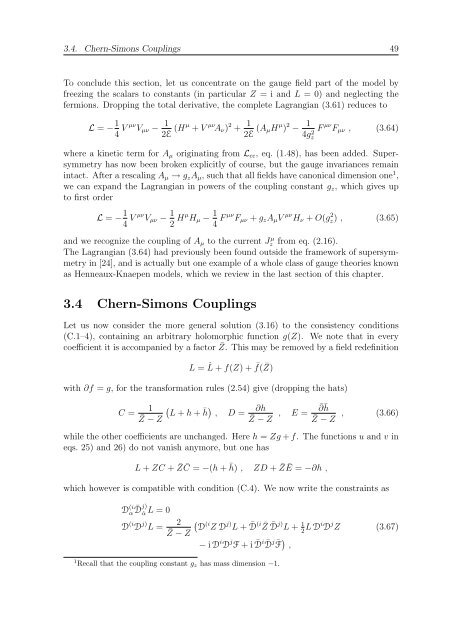N=2 Supersymmetric Gauge Theories with Nonpolynomial Interactions
N=2 Supersymmetric Gauge Theories with Nonpolynomial Interactions
N=2 Supersymmetric Gauge Theories with Nonpolynomial Interactions
Create successful ePaper yourself
Turn your PDF publications into a flip-book with our unique Google optimized e-Paper software.
3.4. Chern-Simons Couplings 49<br />
To conclude this section, let us concentrate on the gauge field part of the model by<br />
freezing the scalars to constants (in particular Z = i and L = 0) and neglecting the<br />
fermions. Dropping the total derivative, the complete Lagrangian (3.61) reduces to<br />
L = − 1<br />
4 V µν Vµν − 1<br />
2E (Hµ + V µν Aν) 2 + 1<br />
2E (AµH µ ) 2 − 1<br />
4g2 F<br />
z<br />
µν Fµν , (3.64)<br />
where a kinetic term for Aµ originating from Lcc, eq. (1.48), has been added. Supersymmetry<br />
has now been broken explicitly of course, but the gauge invariances remain<br />
intact. After a rescaling Aµ → gzAµ, such that all fields have canonical dimension one 1 ,<br />
we can expand the Lagrangian in powers of the coupling constant gz, which gives up<br />
to first order<br />
L = − 1<br />
4 V µν Vµν − 1<br />
2 Hµ Hµ − 1<br />
4 F µν Fµν + gzAµV µν Hν + O(g 2 z) , (3.65)<br />
and we recognize the coupling of Aµ to the current J µ z from eq. (2.16).<br />
The Lagrangian (3.64) had previously been found outside the framework of supersymmetry<br />
in [24], and is actually but one example of a whole class of gauge theories known<br />
as Henneaux-Knaepen models, which we review in the last section of this chapter.<br />
3.4 Chern-Simons Couplings<br />
Let us now consider the more general solution (3.16) to the consistency conditions<br />
(C.1–4), containing an arbitrary holomorphic function g(Z). We note that in every<br />
coefficient it is accompanied by a factor ¯ Z. This may be removed by a field redefinition<br />
L = ˆ L + f(Z) + ¯ f( ¯ Z)<br />
<strong>with</strong> ∂f = g, for the transformation rules (2.54) give (dropping the hats)<br />
C = 1 <br />
¯Z<br />
L + h + ¯ ∂h<br />
h , D =<br />
− Z<br />
¯Z − Z , E = ¯ ∂¯ h<br />
¯Z − Z<br />
, (3.66)<br />
while the other coefficients are unchanged. Here h = Zg + f. The functions u and v in<br />
eqs. 25) and 26) do not vanish anymore, but one has<br />
L + ZC + ¯ Z ¯ C = −(h + ¯ h) , ZD + ¯ ZĒ = −∂h ,<br />
which however is compatible <strong>with</strong> condition (C.4). We now write the constraints as<br />
D (i<br />
α ¯ D j)<br />
L = 0<br />
˙α<br />
D (i D j) L = 2<br />
¯Z − Z<br />
D (i Z D j) L + ¯ D (i ¯ Z ¯ D j) L + 1<br />
2 L Di D j Z<br />
− i D i D j F + i ¯ D i ¯ D j ¯ F ,<br />
1 Recall that the coupling constant gz has mass dimension −1.<br />
(3.67)

















